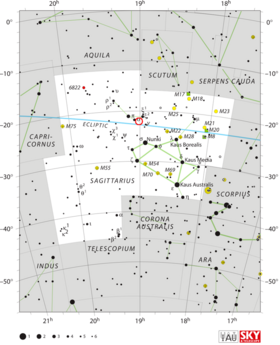Astronomy:V4743 Sagittarii
| Observation data Equinox J2000.0]] (ICRS) | |
|---|---|
| Constellation | Sagittarius |
| Right ascension | 19h 01m 09.38s[1] |
| Declination | −22° 00′ 05.9″[1] |
| Apparent magnitude (V) | 5.0 – 16.8[2] |
| Characteristics | |
| Variable type | CN[3] |
| Astrometry | |
| Distance | ~21,000[4] ly (6,300 pc) |
| Details | |
| Mass | 1.22[5] M☉ |
| Other designations | |
| Database references | |
| SIMBAD | data |

V4743 Sagittarii was a bright nova in the southern constellation of Sagittarius. This event was discovered by K. Haseda and colleagues in September 2002.[1] It peaked at magnitude 5.0[7] on September 20, 2002, then declined rapidly thereafter. It reached a peak temperature of 740,000 K around April 2003 and remained at that level for at least five months, suggesting the white dwarf component has a mass of 1.1–1.2 M☉.[8] The distance to this system is uncertain.[3] Infrared observations indicate a distance of approximately 21 kly (6.3 kpc).[4] A derivation using maximum magnitude rate of decay showed a distance of 12.7 ± 1.0 kly (3.9 ± 0.3 kpc).[8]
Observations of the nova by the Chandra X-ray Observatory taken 180 days after the event showed an amplitude variation with a period of about 22 minutes. The X-ray output was dropping rapidly, and changed from a continuous spectrum to one showing emission lines. X-ray light curves of this system show a periodic signal with a frequency of 0.75 MHz that suggests a rapidly rotating magnetic white dwarf in an intermediate polar system.[9][8] In 2003, an optical variation of 6.74 ± 0.07 hours was observed, and was interpreted as the orbital period of the binary system.[4] A proposed beat period of ~24 minutes has been detected in the optical in between the orbital and period cycles.[3]
References
- ↑ 1.0 1.1 1.2 Haseda, K. et al. (September 2002). "Another nova in Sagittarius". IAU Circular 7975: 1. Bibcode: 2002IAUC.7975....1H.
- ↑ Samus, N. N. et al. (2017). "General Catalogue of Variable Stars". Astronomy Reports. 5.1 61 (1): 80–88. doi:10.1134/S1063772917010085. Bibcode: 2017ARep...61...80S.
- ↑ 3.0 3.1 3.2 Zemko, P. et al. (November 2018). "Optical observations of 'hot' novae returning to quiescence". Monthly Notices of the Royal Astronomical Society 480 (4): 4489–4504. doi:10.1093/mnras/sty2061. Bibcode: 2018MNRAS.480.4489Z.
- ↑ 4.0 4.1 4.2 Leibowitz, E. et al. (September 2006). "Variability and multiperiodic oscillations in the X-ray light curve of the classical nova V4743 Sgr". Monthly Notices of the Royal Astronomical Society 371 (1): 424–430. doi:10.1111/j.1365-2966.2006.10684.x. Bibcode: 2006MNRAS.371..424L.
- ↑ Shara, Michael M. et al. (June 2018). "The Masses and Accretion Rates of White Dwarfs in Classical and Recurrent Novae". The Astrophysical Journal 860 (2): 11. doi:10.3847/1538-4357/aabfbd. 110. Bibcode: 2018ApJ...860..110S.
- ↑ "V4743 Sgr". SIMBAD. Centre de données astronomiques de Strasbourg. http://simbad.u-strasbg.fr/simbad/sim-basic?Ident=V4743+Sgr.
- ↑ Watson, Christopher. "VSX : Detail for V4743 Sgr". aavso.org. https://www.aavso.org/vsx/index.php?view=detail.top&oid=32443.
- ↑ 8.0 8.1 8.2 Zemko, P. et al. (August 2016). "V4743 Sgr, a magnetic nova?". Monthly Notices of the Royal Astronomical Society 460 (3): 2744–2751. doi:10.1093/mnras/stw1199. Bibcode: 2016MNRAS.460.2744Z.
- ↑ Dobrotka, A.; Ness, J. -U. (June 2017). "Counter-evidence against multiple frequency nature of 0.75 mHz oscillation in V4743 Sgr". Monthly Notices of the Royal Astronomical Society 467 (4): 4865–4871. doi:10.1093/mnras/stx442. Bibcode: 2017MNRAS.467.4865D.
Coordinates: ![]() 19h 01m 09.33s, −22° 00′ 05.8″
19h 01m 09.33s, −22° 00′ 05.8″
 |


